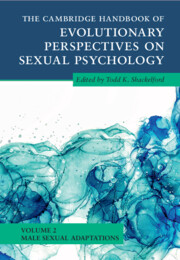Book contents
- The Cambridge Handbook of Evolutionary Perspectives on Sexual Psychology
- The Cambridge Handbook of Evolutionary Perspectives on Sexual Psychology
- Copyright page
- Contents
- Contributors
- Preface
- Part I Precopulatory Adaptations
- 1 Men’s Sexual Preferences
- 2 Men’s Extra-Pair Sexual Interest
- 3 Male Sexual Attraction Tactics
- 4 Men’s Intrasexual Competition
- 5 Competitiveness and Fatherhood as Overarching Domains of Female Choice in Human Evolution
- 6 Sexual Coercion and Rape
- 7 Mate Poaching by Men
- Part II Copulatory Adaptations
- Part III Postcopulatory Adaptations
- Index
- References
1 - Men’s Sexual Preferences
from Part I - Precopulatory Adaptations
Published online by Cambridge University Press: 30 June 2022
- The Cambridge Handbook of Evolutionary Perspectives on Sexual Psychology
- The Cambridge Handbook of Evolutionary Perspectives on Sexual Psychology
- Copyright page
- Contents
- Contributors
- Preface
- Part I Precopulatory Adaptations
- 1 Men’s Sexual Preferences
- 2 Men’s Extra-Pair Sexual Interest
- 3 Male Sexual Attraction Tactics
- 4 Men’s Intrasexual Competition
- 5 Competitiveness and Fatherhood as Overarching Domains of Female Choice in Human Evolution
- 6 Sexual Coercion and Rape
- 7 Mate Poaching by Men
- Part II Copulatory Adaptations
- Part III Postcopulatory Adaptations
- Index
- References
Summary
Evolutionary sexual psychology posits that sexual preferences evolved in response to recurring adaptive problems faced by men and women in regard to reproduction and mating. Accordingly, asymmetries in the mating-related problems faced by the sexes should result in sex-differentiated preferences. Some asymmetries which could be expected to result in sex-differentiated preferences include: 1) the length of time during which one is able to produce offspring (much longer for men as compared to women, which is posited to result in men showing a preference for partners who display cues to fertility and reproductive viability); 2) minimum investment needed to produce offspring (much greater for women as compared to men, which is posited to result in men showing a greater preference for short-term mating relative to women); and 3) certainty of maternity/paternity of offspring (much greater for women as compared to men, which is posited to result in men showing preferences which mitigate partner infidelity and sperm competition). Consistent with the predictions of evolutionary sexual psychology, many of the physical characteristics which men find to be attractive in women are associated with fecundity (e.g., a low waist-to-hip ratio, youthfulness). Men do appear to display a greater interest in engaging in short-term mating relative to women. Men self-report more permissive attitudes toward casual sex, desire a greater number of sexual partners across various time periods, and report being more motivated by casual sex when dating or using dating apps. Large representative surveys frequently find a sizable sex difference in the number of sexual partners reported over the lifespan, although the degree to which this may reflect factors like differences in the way that men and women respond to such questions (e.g., estimating versus counting) is debated. Field experiments indicate that men are more inclined to accept offers of casual sex from opposite-sex strangers, and men appear to be more likely to pay for sex. The content of sexual fantasies and pornography also offer insights into the nature of men’s sexual preferences. Men’s sexual fantasies more frequently involve elements of sexual variety and nonmonogamy (e.g., casual sex with multiple partners). Men also appear to consume pornography more frequently than women, which may reflect pornography providing vicarious access to excellent short-term mating opportunities in the form of a myriad of virtual partners who are youthful, attractive, and display unusually high levels of sexual accessibility. The contents of pornography, and themes common to men’s sexual fantasies, also demonstrate a preoccupation with partner infidelity.
Keywords
- Type
- Chapter
- Information
- Publisher: Cambridge University PressPrint publication year: 2022



